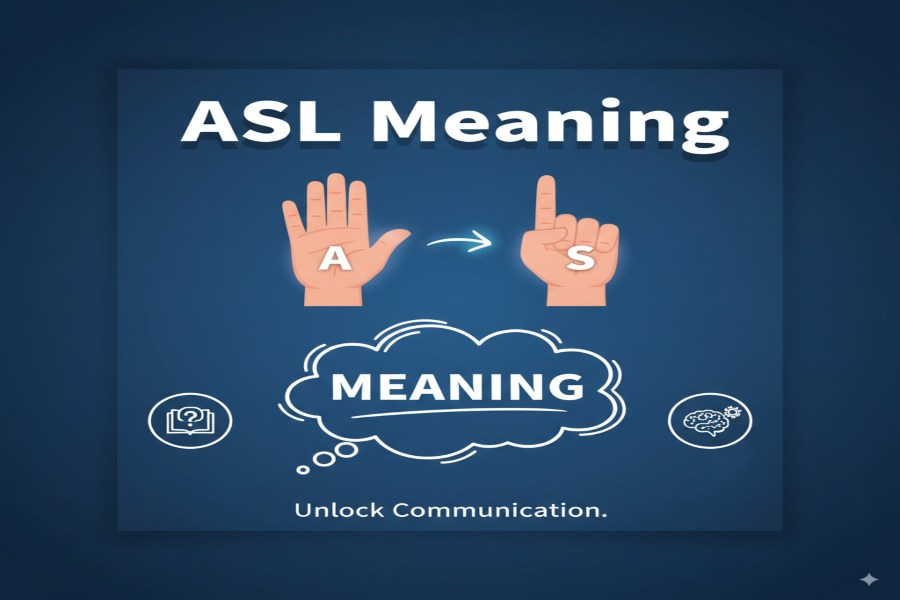American Sign Language (ASL) is a powerful, rich, and expressive visual language used primarily by the Deaf community in the United States and parts of Canada. With over 730,000 native signers, ASL has become not only a means of communication but also a cornerstone of Deaf culture.
Understanding ASL’s origins, structure, and significance can bridge the gap between communities and promote better inclusion and communication. This article explores the meaning of ASL, its history, grammar, and cultural impact.
What is American Sign Language?
ASL is a complete language that uses hand gestures, facial expressions, and body movements to convey meaning. Unlike spoken languages that rely on vocal sounds, ASL is based entirely on visual input. It serves as a primary language for many Deaf individuals, providing them with the ability to communicate independently of spoken words.
ASL is not a universal language. Each country has its own sign language, and even regions within a country may have different variations. For instance, British Sign Language (BSL) differs significantly from ASL, and Canadian Sign Language (CSL) is another example of a regional variant. This makes ASL unique to the U.S. and parts of Canada.
The Origins of ASL
ASL developed in the early 19th century, influenced by a variety of sign languages used by the Deaf community. It is particularly rooted in French Sign Language, which was brought to the U.S. in the early 1800s by Laurent Clerc, a French educator who co-founded the first school for Deaf students in the U.S.

At the time, Martha’s Vineyard Sign Language also played a role in shaping ASL. Martha’s Vineyard, an island off the coast of Massachusetts, had a large population of Deaf individuals. The unique signing system there influenced the development of ASL.
Through these various influences, ASL evolved into a distinct language with its own grammar, vocabulary, and syntax, making it vastly different from English.
Grammar and Syntax of ASL
One of the key features of ASL is its unique grammar, which differs significantly from English. In English, sentences generally follow a Subject-Verb-Object structure, but in ASL, the sentence structure often follows a Topic-Comment format.
For example:
- In English: “I am going to the store.”
- In ASL: “Store, I go.”
In this structure, the “Topic” (store) comes first, followed by the comment (I go).
ASL also places great emphasis on facial expressions and non-manual signals. These facial expressions can convey tone, mood, and grammatical information, such as whether a sentence is a question, a statement, or an exclamation. For example, raising eyebrows while signing indicates a question.
Another important aspect of ASL grammar is the use of classifiers. Classifiers are handshapes that represent categories of objects or people. They help convey the size, shape, and movement of these objects or people in the context of a sentence.
The Importance of ASL in Deaf Culture
ASL is more than just a language—it is a vital part of Deaf culture. For many Deaf individuals, ASL is their first language, and it helps shape their social identity. The language is deeply embedded in the traditions, history, and daily lives of Deaf communities.
ASL fosters a sense of community among Deaf people and serves as a tool for inclusion. Deaf culture places a high value on visual communication, and ASL provides the framework for this unique form of interaction. It allows Deaf individuals to communicate effortlessly and fluently with one another, without needing to rely on lip-reading or written communication.
Moreover, ASL has contributed to the creation of Deaf literature, art, and performance. Many poets, playwrights, and performers use ASL as a medium for artistic expression. ASL storytelling is particularly powerful, with its use of hand gestures, facial expressions, and body movements to evoke emotions and tell rich, nuanced stories.
Misconceptions About ASL
There are several misconceptions about ASL that can hinder its appreciation and understanding:
- ASL is not universal: While it is a common misconception that all sign languages are the same worldwide, ASL is specific to the U.S. and Canada. Many countries have their own distinct sign languages, such as British Sign Language (BSL) and Australian Sign Language (Auslan).
- ASL is not English: ASL is often mistakenly thought to be a direct translation of English into sign. However, ASL has its own grammatical rules and structure, which are quite different from English. ASL cannot be learned by simply translating English words into signs.
- ASL is only for the Deaf: While ASL is primarily used by the Deaf community, it is also used by hearing individuals who communicate with Deaf people. Many people—such as family members, educators, interpreters, and medical professionals—learn ASL to better communicate with Deaf individuals.
- ASL is easy to learn: While ASL is a visual language and can be more intuitive for some learners, it still requires dedication and practice. Like any language, mastering ASL requires a deep understanding of its grammar, syntax, and cultural nuances.
The Role of ASL in Education and Advocacy
In educational settings, ASL plays a crucial role in promoting accessibility for Deaf students. ASL interpreters are commonly employed in classrooms to bridge the communication gap between Deaf students and their hearing peers. Additionally, many Deaf schools use ASL as the primary language of instruction.
ASL is also used to advocate for the rights of Deaf individuals. Many advocacy groups, such as the National Association of the Deaf (NAD), promote the use of ASL in schools, workplaces, and public life. Their efforts have led to greater recognition of ASL and its importance in the Deaf community.
ASL in Modern Media and Technology
In recent years, ASL has gained more visibility through social media, films, and TV shows. Many social media influencers and content creators are using ASL to reach Deaf audiences, and TV shows like Switched at Birth and films like CODA have brought ASL into the mainstream.

Technology has also played a significant role in promoting ASL. Video platforms like YouTube and TikTok feature tutorials, skits, and vlogs in ASL, providing a platform for Deaf creators to showcase their talent. Apps and online courses are also available to help people learn ASL at their own pace.
How to Learn ASL
Learning ASL can be a rewarding experience, whether you are part of the Deaf community or simply want to communicate more effectively with Deaf individuals. Here are some steps to get started:
- Take a Class: Many community colleges, universities, and local organizations offer ASL classes. These classes provide a structured environment for learning and allow you to practice signing with others.
- Use Online Resources: Numerous websites, mobile apps, and video platforms offer ASL lessons. Websites like ASL University and apps like The ASL App are great places to start learning from home.
- Practice with Native Signers: The best way to become fluent in ASL is to practice with people who use it as their first language. Joining a local Deaf club or attending social events can provide opportunities to learn in an immersive environment.
- Watch ASL Content: Watching ASL videos, such as those on YouTube, can help you improve your signing skills. Pay attention to facial expressions, body language, and handshapes to understand the language in its cultural context.
Conclusion
American Sign Language is a powerful and essential language for the Deaf community. It is much more than a tool for communication; it is an integral part of Deaf culture and identity. By understanding ASL’s grammar, history, and cultural significance, we can foster greater inclusivity and appreciation for this beautiful language.
Whether you are learning ASL for personal, educational, or professional reasons, it is a language that connects people, builds communities, and bridges gaps. Embracing ASL can enrich your life and open up new possibilities for meaningful communication and relationships with Deaf individuals.

